On Monday, I had the opportunity to photograph three of the Utah Jazz’s stars players: Andrei Kirilenko, Carlos Boozer and Deron Williams. The concept for this shoot was to show the trio “rising-up,” with the expectations of them to lead the Jazz to their first post-season play in three years.
My photo editor Scott Sommerdorf came to me with the idea of shooting the players from below, to give the illusion that they were floating in the air. It was my job to figure out a way to accomplish this.
I had seen this type of portrait done before using a sheet of Plexiglas and other NBA stars, so I knew it could be accomplished. To get more advice and tips I searched the Sportshooter.com message board archive. I found a thread where a few shooters discussed their approach and gave helpful tips. The main thing I learned was the thicker the Plexiglas, the better.
The next step was finding a sheet of Plexiglas that could hold up the 200+ pound athletes. I called a few plastic distributors in Salt Lake to get price quotes on a piece of plexi that was 4x4 feet wide and one-inch thick. The sheet alone was going to cost almost $300 and I could not find a way to securely elevate it four feet above the ground, so I continued searching for other options.
My luck changed when I went to a local professional theater supply store and told them what we wanted to do. They just-so-happened to have a pre-made 4x8 foot Plexiglas stage available for rent. The one-inch thick sheet was reinforced with a four-inch steel frame weighed over 200 pounds. In order for it to be stable at four-feet high, we also had to rent two other 4x8’ stages that would be attached to either side of the Plexiglas.
On the day of the shoot, Scott and I arrived at the Jazz practice facility at 9 am and started to unload the rental truck with the stage. Due to the size of the stage, this had to be outside. Thankfully, the weather was a comfortable 54-degrees, without a cloud in the sky. It took us about thirty minutes to assemble the stage and then another thirty-minutes to set-up the portable studio strobes and wipe down the Plexiglas. I feel like I could now be a roady for Metallica.
I made a few test shots of Scott and Tribune Jazz reporter Phil Miller to make sure the lighting was correct and to fix any glare problems. After a few more final adjustments we were ready for the players. The only thing left to do was wait until their practice was over -- which gave my paranoid mind plenty of time to envision the worst-case scenario. I could see the headlines in tomorrow’s paper:
“Kirilenko suffers career-ending Achilles tendon tear after crashing through Plexiglas during photo shoot. Tribune photographer crushed in incident.”
Andrei Kirilenko, 6’9”, 225 lbs., was the first to come out at 12:27 pm. He was cordial and did not hesitate to stand on the Plexiglas. We had two new synthetic game balls to use as props and I was surprised when Andrei said he could not palm the ball. Two minutes and 31 frames later, his shoot was over.

Carlos Boozer, 6’9, 266 lbs., came out next. I shook his hand and told him my name. He paused for a second and said, “Detrick. That sounds familiar.” I am not sure if it is a good or bad thing that he recognizes my name, but for now, I will take it as a compliment. I managed to make 48 frames in the two minutes Boozer gave me.

Jazz guard Deron Williams was the final player to come out for the shoot. He was the smallest of the three at 6’3”, 210 lbs. To further the illusion that he was floating in the air, I had him lift his right leg into the air while he passed the ball under his leg to Phil, who was standing out of the frame. Williams got into the shoot more than the others, and stayed out for an entire five minutes, in which I made 90 frames.

After the shoot, Scott, Phil and I tore down the stage and went out to lunch to edit the photos on my laptop. We picked the three best that would be published on the Sports front the morning of the Jazz season opener against the Rockets.
After weeks of planning and coordination, it was over. I made some fun pictures of NBA stars– and the Plexiglas didn’t break.

This is how the pictures ran in the paper. I am not thrilled with how they chose to cut out each of the players, then add the semi-opaque streaks, but it could have been worse. I would have rather seen just one main picture with the other two smaller on the page.
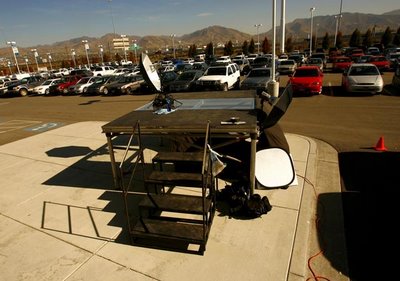
This was the setup of the photo shoot. We rented three 4x8 foot stages. The middle one was made out of one-inch thick plexiglas. They were four feet high and all together, weighed almost 500 lbs.
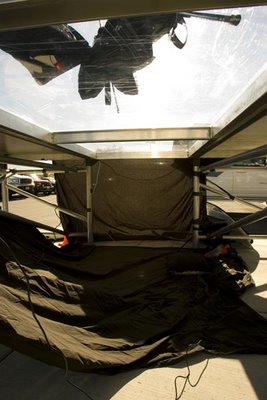
This is where I shot from. The black sheets helped to reduce the glare and reflections on the plexiglas. Having four feet of clearance gave me more room to shoot from and helped to minimize the wide-angle distortion that would have been more prominent at a closer distance.
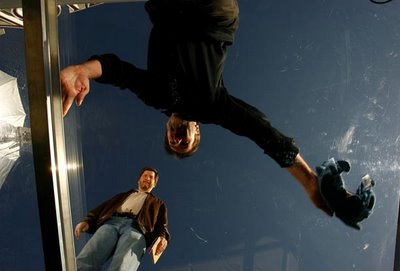
My photo editor Scott Sommerdorf cleans the plexiglas before the shoot. Jazz reporter Phil Miller is in the background.
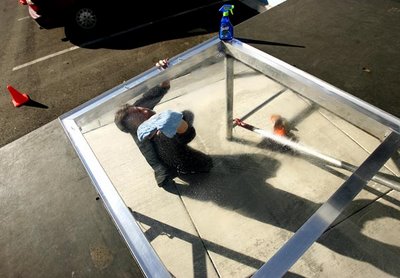
The top view of Scott cleaning the plexi.
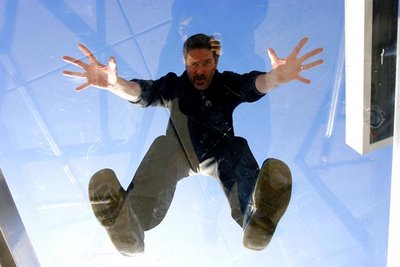
Scott standing in for a test shot. Notice you can see the side walk and myself reflected in the plexi. By having the black sheets, these reflections were eliminated. This shot was also taken without using the portable studio strobes.
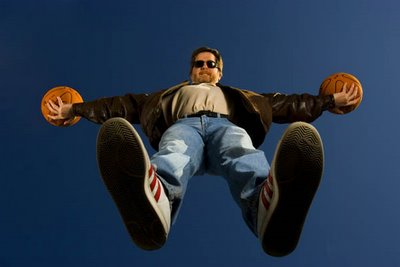
Tribune Jazz reporter Phil Miller stands in for one final test shot to make sure all of my exposure and light settings were correct before the players arrived.

Here are some outtakes from the shoot.